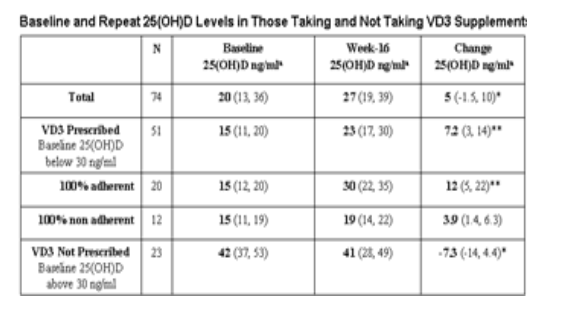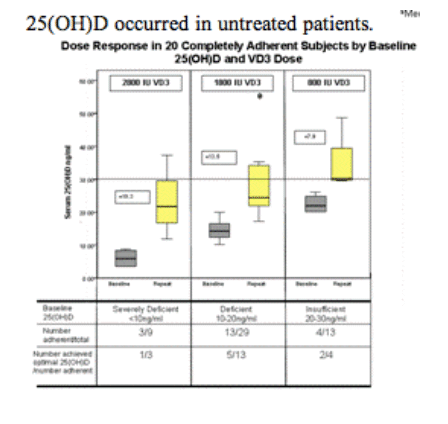 |
 |
 |
| |
First Report of Dose/Response Data of HIV-infected Men Treated with Vitamin D3 Supplements
|
| |
| |
Reported by Jules Levin
CROI 2009 Feb 8-12 Montreal
from Jules: one should consider researching safety of such high dose vitamin D before embarking on such high dosing.
Kathryn Childs*, S Fishman, S Factor, D Dieterich, M Mullen, and A Branch
Mt Sinai Sch of Med, New York, NY, US
Background: Among the general public, low vitamin D levels have many adverse health effects including enhanced inflammation. HIV infection causes inflammation and may increase the importance of optimal vitamin D, defined as 30 to 60 ng/mL of 25-hydroxyvitamin D (25[OH]D). Studies are needed to determine the doses of vitamin D3 (VD3) required by HIV patients.
Methods: With investigational review board (IRB) approval, 25(OH)D status was assessed in 74 HIV-infected men during the winter in New York of whom 51 with 25(OH)D <30 ng/mL were prescribed daily oral VD3 at doses based on the baseline 25(OH)D level: 2800 IU for <10 ng/mL (severe deficiency); 1800 IU for 10 to 20 ng/mL (deficiency); 800 IU for 20 to 30 ng/mL (insufficiency). All subjects were prescribed 1 g of calcium, as calcium citrate. The level of 25(OH)D was measured at a median follow up of 16 weeks, during summer.
Results: Most of the 74 men (84%) were Caucasian. The median CD4 count was 444 cells/μL. Among the 51 (69%) prescribed VD3, 25(OH)D increased by a median of 7.2 ng/mL (from 15 to 23 ng/mL) on an intention-to-treat basis (p <0.001; table). Among the 20 subjects who reported 100% adherence, 25(OH)D rose by 15 ng/mL (from 15 ng/mL to 30 ng/mL), allowing 8 of 20 (40%) to achieve optimal 25(OH)D status. As expected, the greatest increases in serum 25(OH)D occurred in the men with the lowest baseline levels. These men were prescribed 2800 IU VD3/day, the highest dose (figure). Only 1 of the 12 non-adherent men (8%) achieved an optimal 25(OH)D level in the summer. Serum calcium remained below the ULN in all subjects prescribed VD3. Surprisingly, no winter to summer seasonal increase occurred among the 23 men with 25(OH)D>30 ng/mL at baseline (who were not prescribed VD3). Rather, median winter and summer levels were 42 and 41 ng/mL, respectively; the median change was -7.3 ng/mL. Of 23 (65%) men, 15 with 25(OH)D levels >30 at baseline had a winter-to-summer decrease.
Conclusions: To our knowledge, our study provides the first dose/response data for oral VD3 in HIV patients. Doses as high as 14 times the Recommended Daily Allowance were safe and did not lead to hypercalcemia in any subject. VD3 increased 25(OH)D levels, allowing 8 of 20 (40%) fully adherent subjects to achieve 25(OH)D levels in the optimal range. The dose/response effects we observed indicate that many HIV patients can achieve optimal vitamin D status by using oral VD3. Of note for future dose/response studies, minimal seasonal variation in 25(OH)D occurred in untreated patients.


|
| |
|
 |
 |
|
|